Video of the Week:
When is Cantaloupe Ripe on the Vine?
Upcoming Events:
https://turffieldday.eventbrite.com
The field day program is designed for all segments of the turf industry - lawn care, athletic fields, golf courses, and grounds maintenance. Included on the program are research presentations, problem diagnosis, commercial exhibitors, and equipment displays. There will be time to see current research, talk to the experts and get answers to your questions. Pesticide recertification credit in 3B is available and 0.25 GCSAA education points
August 15 K-State Vegetable Research Field Day, Olathe
http://hnr.k-state.edu/events/2016%20GG%20Vegetable%20Research%20Tour.pdf
Fruit:
When Are Apples Ready to Pick?
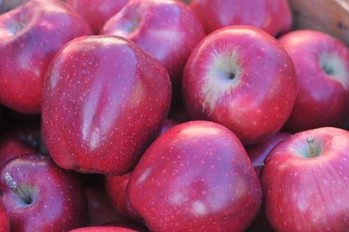
Color change: As apples mature, the skin color in areas of the stem and the calyx basin at the bottom of the apple turns from an immature green to a light-yellow color. Some apples will develop a red skin color before they are ripe, so this is not a reliable indication of maturity.
Flavor: This is a good guide if you are familiar with the apples you have and know how they should taste. Even if you do not know the characteristic flavor of the kind of apple you have, you can still sample slices of a few apples and decide if they have a sweet flavor. If they are not ready to harvest, they will taste starchy or immature. If apples have already fallen and taste a bit starchy, store them for a period to see if they become sweeter.
Flesh color: As apples mature and starches change to sugars, the flesh changes from very light green to white. When you cut a thin slice and hold it up to the light you can see the difference.
Days from bloom: The number of days from bloom is a reliable guide for general maturity time, but weather conditions will have some influence. Some kinds of apples and approximate days from bloom to maturity are Jonathan, 135, Delicious, 145, Golden Delicious, 145, and Winesap,155 days. This process may be slower than usual due to the cooler weather this year.
Seed color: The seeds of most apples change from light green to brown as the fruit ripens. This indicator should be combined with other changes since it is not absolute. The flavor of the apples, the change in color of the stem and calyx basins and flesh color are important in deciding if apples are ready to harvest. (Ward Upham)
Peaches; Pitburn and Split Pits
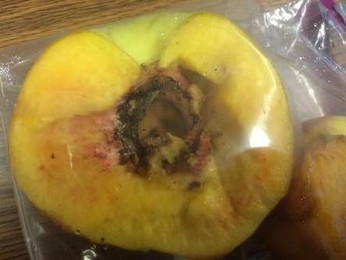
Pitburn is evidenced by brown or gray areas around the pit and is caused by high temperatures and rapid growth. It actually isn’t the high temperatures that injure the flesh directly but a lack of oxygen interfering with normal development. Remember the very high temperatures we had earlier in the year? Those high temperatures led to pit burning.
Split pits are also often the result of rapid growth and can be made worse with excessive thinning and/or irregular watering during the pit hardening stage. Such peaches are more likely to rot than those with intact pits.
There isn’t anything that can be done at this stage to help the peaches. However, a good job of watering and avoiding overthinning can help prevent split pits in the future. Peaches with pitburn or split pits are safe to eat. (Ward Upham)
Vegetables:
Fall Gardens
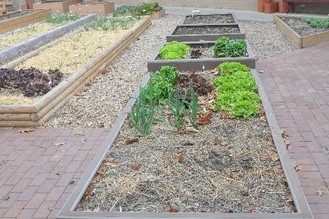
Planting a fall garden is just like planting a spring garden with some big advantages. You will find the weed pressure to be much less and insect problems may be far fewer than in a spring garden. Seeds will germinate rapidly, so you will have crops up and growing in just a few days – compared to several weeks in the spring.
There are a few drawbacks to fall gardening, and one of those is that you must provide regular, frequent watering (possibly daily) until the crops are up and growing. It is best to plant seeds deeper than you do for a spring garden because soil is cooler and moister down a little deeper.
As far as soil preparation is concerned, don't get too excited about deep tillage for a fall garden. Lightly work the soil enough to establish a seedbed; reserve your deep tillage for later in the fall. Also, don't concentrate on adding a lot of organic matter and fertilizer for the fall garden. The organic matter can be added later in the fall with the deeper tillage, and excessive fertilizer application in hot weather is not a good idea. If you have some crop residue to remove from a previous crop, chop the residue with a lawn mower and lightly till the soil surface after the residue has had a chance to dry for 2 to 3 days. (Ward Upham)
Pests:
Chiggers
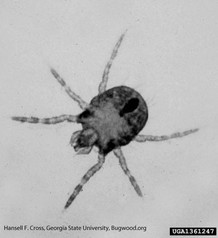
Protection from chiggers uses two approaches. The use of a repellent can discourage chiggers from attacking. The most effective repellents are Deet and permethrin. Both are applied to clothing. The second approach seeks to reduce chigger populations. Keeping the lawn mowed regularly can help, but large populations may require the use of an acaricide. Effective products include bifenthrin (Talstar, Hi-Yield Bug Blaster II, Hi-Yield Bug Blaster Bifenthrin, and Ortho Lawn Insect Killer Granules), cyfluthrin (Tempo 20, Bayer Vegetable & Garden Insect Spray) and carbaryl (Sevin). For more information, see the K- State Research and Extension publication titled, “Chiggers” at: http://www.ksre.ksu.edu/bookstore/pubs/MF2107.PDF (Ward Upham)
Miscellaneous:
Pokeweed
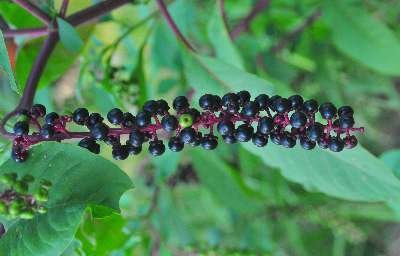
Surprisingly, young leafy springtime shoots are sometimes eaten after thorough cooking. Though cooking eliminates most of the toxins, there is still a danger of being poisoned from handling and preparing the shoots as well as ingesting improperly cooked plants.
Berries can be attractive to children. Cut down and discard pokeweed that might come into contact with kids. This plant is a perennial. You may want to spray it with a herbicide next year before it is large enough to be attractive to children. (Ward Upham)
Pesticide Effectiveness
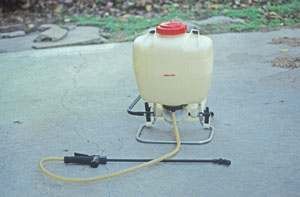
1. Lack of good foliage penetration. This often is a problem when spraying for bagworms on junipers. The spray must penetrate the foliage and reach the bagworms toward the inside of the plant. High-pressure commercial sprayers are able to get the spray to the insects but homeowner models are much more problematic. With pump-up sprayers, you may have to push the wand through the outer layer of foliage to reach insects toward the inside of the plant.
2. Not spraying where the insect is. Many of our insects and mites feed on the underside of leaves. If the plants are sprayed over the top, little to no pesticide reaches the pests. This problem is often seen with spider mites on broadleaf plants and cabbage worms on cabbage, broccoli and cauliflower.
3. Maturity of pest. Insects become much more difficult to control when they become adults. For example, Sevin does a good job of controlling young, early instar grasshoppers but is much less effective on adults.
4. Level of disease pressure. Most fungicides are better used as preventatives than as curatives. If a disease gets firmly established, it may be difficult to bring it back under control. For example, chlorothalonil is effective in controlling early blight and Septoria leaf spot on tomato if used as a preventative. However, chlorothalonil will not control these diseases on badly infested plants.
5. Choosing the wrong product. Homeowners often use a product they have on hand. However, products differ markedly in how well they control specific pests. Make sure the pest you wish to control is on the label. Unfortunately, even labeled products may vary in effectiveness. Check K-State Research and Extension recommendations for products.
6. Using the wrong rate. Using less than recommended rate can reduce effectiveness but using more can also cause problems. For example, using a systemic herbicide such as Roundup at higher than recommended rates can burn off the top of the plant before the herbicide is translocated to the roots, thereby reducing effectiveness.
6. High pH spray water. Certain pesticides are not stable in high or low pH water. Following are some examples.
* Captan has a half-life of 3 hours at a pH of 7.0, but only 10 minutes at a pH of 8.0.
* Carbaryl (Sevin) has a half-life of 24 days at pH 7.0, but only 1 day at pH 9.
The half-life of a product is the amount of time it takes for half of the product to be neutralized. For example, if you apply 3 ounces of a product to a gallon of water and the half-life is 8 hours, only half of the product is still active at 8 hours, one-fourth of the product is active 16 hours and 1/8 of the product is still active at 24 hours. (Ward Upham)
Contributors: Ward Upham, Extension Associate
 RSS Feed
RSS Feed
